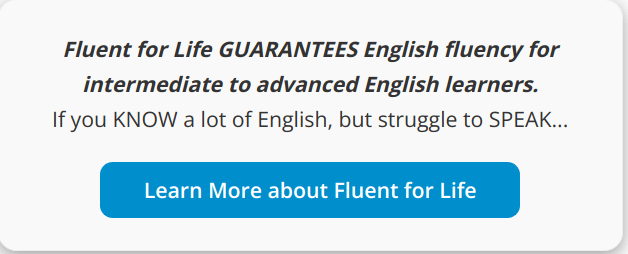English
How to Learn English FAST (Ignore Traditional Methods!)
How satisfied are you with the progress you have made with traditional language learning methods?
You memorized all of the words, lists, and rules for speaking English… but you still don’t feel fluent.
Traditional language learning methods have failed you. They taught you to memorize rules and repeat them by rote.
These methods are ineffective for most people. Studying endless lists of verbs, idioms, and vocabulary won’t help you become fluent.
The fastest way to learn English is through input (getting messages you understand), not output (speaking).
In adulthood, you can greatly speed up this process by having a teacher who systematically conveys these understandable messages.
You will learn how to learn English FAST by following the steps below.

Contextualize words and phrases
You memorize as many words and phrases as you can in traditional language learning methods without understanding their context.
Learning words and phrases in context is important – it gives them greater depth and meaning.
Consider the word “sour.”
Often, we use the word “sour.” in a negative sense. If the milk is sour, it means it’s expired and no longer tastes good.
You can also give someone a sour look. This doesn’t mean you’re expressing resentment, disappointment, or anger, but rather that you’re expressing resentment, disappointment, or anger.
If you’re into cocktails, you can also order a whiskey sour – a drink made with strong alcohol, lime juice, sugar, and ice.
Understanding the context in which words and phrases are used is crucial to interpreting conversations correctly. Context provides us with the necessary background information to understand the conversations around us. It makes it much easier to understand what’s going on. Without proper context, you might misunderstand or misinterpret the situation.
If I tell you that my relationship with my best friend soured, you’ll know that I’m not talking about a drink.
Whenever I can connect the word in different contexts, I can use it in a new context and you can figure out its meaning more easily.

Make Sure Your Teacher Is Skilled
Again, the faster you get understandable messages, the faster you get fluent. So a skilled teacher can be the most important tool in your fluency-building toolbox.
While they can be extremely helpful on your way to fluency, they must be able to teach you English as a FIRST language, rather than just give you more word lists and rules.
Your teacher may not be a good fit for your path to fluency if they require rote repetition and vocabulary memorization.
According to research, this is not the best method for learning a language quickly.
When children learn a language, they connect words with situations and receive input from hundreds of people.
Engage in active listening to real, spoken English
Rather than worrying about what to say next, focus on what the other speaker is saying.
Ultimately, English is learned through input, not output. And the best thing about conversations is that they provide lots of new information.
Spending more time actively listening can help you gain a deeper understanding of the language, which in turn will help you speak more confidently. The more time you spend actively listening, the more likely you are to understand the context in which the words are being spoken.
Taking the pressure off of speaking and listening to others helps you learn more. Not to mention, everyone appreciates being listened to!

Utilize naturally varied reviews
In addition to being one of the best ways to learn English, Naturally Varied Review is essential to learning any language.
A Natural Varied Review involves reviewing as much varied content as possible. One example is hearing different people say the same phrase, which improves your listening and pronunciation skills.
Listening to different people discuss a particular topic also develops a native vocabulary and fluency.
Start by choosing a topic YOU are interested in – tennis, for example. Next, find several YouTube videos of English speakers discussing the topic. Observe them several times and really soak up the information. Next, you might want to look for news articles or blog posts about tennis.
You’ll quickly build a native vocabulary if you expose yourself to several sources on the same topic, as well as improve your listening skills.
Practice your pronunciation
A major problem for English learners is that they know a lot, but don’t feel or sound confident.
You can improve your speaking ability and confidence by improving your pronunciation not only to sound more like a native English speaker, but also to sound more like one!
A reading, speaking, and listening app called Frederick helps you better memorize the sound rules of English and improve your English pronunciation.
As native English-speaking children learn to read and say English words, Frederick will help you learn the sounds of each letter.
Fun animations, images, and games make learning English more enjoyable, as well as making everything more memorable.

Take a fluency course
Of course, if you want the shortest path to speaking success, you need a fluency course designed to deliver fast results. Historically, fluency courses have not delivered on their promises. But this may have been due to the way they did things.
To speak English in the real world, you need to practice with REAL English, not rote memorization methods.
Fluent For Life is the ONLY course that gives you all the Naturally Varied Review you need to build fluency by yourself.
In this course you will learn real speech, visual examples, and simple stories about topics that interest you, making it so much easier to improve your speaking ability.
Don’t speak until you’re comfortable
Speaking only when you’re comfortable is a more effective way to learn English than forcing yourself to do so.
This is because, as I explained earlier, your first priority should be listening. Inputs, not outputs, lead to fluency. According to Dr. Stephen Krashen’s Input Hypothesis of Language Acquisition, fluency emerges as you gain a deeper understanding of a language.
Taking the pressure off of speaking allows you to learn, remember, and use your vocabulary more effectively.

Using narratives and stories to help you remember vocabulary
The traditional method of teaching English requires you to memorize as many words as possible, but it doesn’t teach you how to apply them in a real-life setting.
In order to remember vocabulary and the context in which it can be used, we use narratives and stories. English idioms are a good example of stories used to memorize vocabulary.
A phrase such as “It’s raining cats and dogs!” tells you that it is raining heavily, not that cats and dogs are falling from the sky. But the image of cats and dogs falling from the sky can help you remember that it is raining heavily.
With Fluent For Life, you can learn English fast and sound like a native speaker
Pairing the tools we’ve discussed today with the Fluent For Life fluency course will help you learn English fast.
Would you like to learn more about Fluent For Life and its proven roadmap to guaranteed English fluency?
CLICK THE LINK BELOW
EnglishAnyone The Vault – Fluent For Life – 80% OFF


